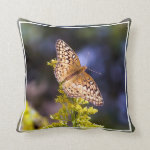The Question Mark Butterfly
Polygonia interrogationis
The Question Mark butterfly is a beautiful little creature and is quite common in Ohio during the summer months and is found throughout a large portion of the Eastern United States. These butterflies a red-orange color with black spots. Depending on the season their hindwings are different colors. During the summer months the hindwings are a dark brownish black color and in the fall they have the beautiful orange color that is edged in violet. When these butterflies close their wings they look like a dead brown leaf which is great camouflage for protecting them from predators.
The Question Mark butterfly is native to Ohio and is found primarily in openings in wooded areas and is rarely seen in developed areas. Its flight periods occur in June, July, August, and September. They feed on rotten fruit, tree sap, animal dung and carrion. When it is available they will also feed on the common milkweed, aster, and the sweet pepperbush. Males are also attracted to mud puddles.
These winged beauties get their name from a little marking on their hindwings that resembles a question mark. This marking can be seen as they are perched with their wings closed.
Question Mark butterflies are one of the longest living Ohio butterflies, along with the Comma and the Mourning Cloak. All three of these butterflies are known to hibernate as adults during the winter. They will find hollow logs and crevices to hide in. This allows them to stay safe from predators the cold Ohio winter elements. Once they emerge in the spring, they can be up to 8 months in age.
During afternoon hours the males will sit and wait for females to fly by so they can mate. They will fend off other butterflies, insects and even birds as they are waiting. Females will then lay their eggs on the underside of leaves. They might lay them individually or they might stack them. Most butterflies will lay their eggs on a host plant, but not these butterflies. Once the Question Mark Butterfly caterpillars hatch they will have to fend for themselves and find a host plant to feed on. The host plants of the Question Mark larval stage include the American elm, red elm, hackberry, hops and nettle.
The larva of the Question Mark butterfly is a scary looking thing. The head is a reddish-brown color and is covered in small spines and two larger spines. The body is black with white or yellowish spots and lines. The whole body is covered in rows of branched spines, also known as scoli. The spines range in color from a reddish-orange to yellow to black.













